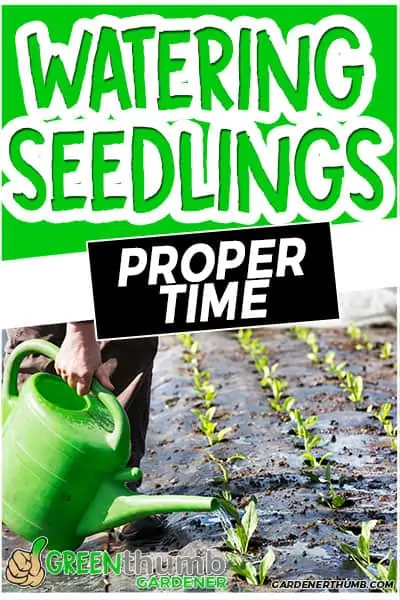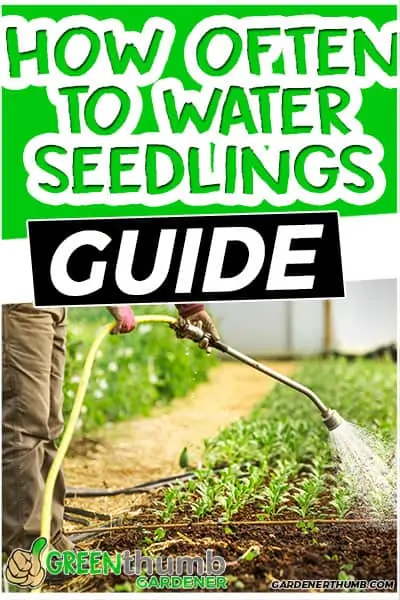How Often To Water Seedlings Guide
Last updated: 06/16/21
The more you water the seedlings, the more it will grow, as long as you keep it fed. As you can guess, this means that you need to be very careful when you water your plants.
Water too much and you can kill a plant. You can also kill your plant by overwatering then underwatering.
This totally defeats the purpose of planting them in the first place. In this article, you will learn the inside scoop on how often you should really be watering your seedlings to ensure that you end up with a healthy adult plant.
Green thumb Gardener occasionally links to product and/or services offered by vendors to assist you with all your gardening needs. Some of these may be affiliate links, meaning we earn a small commission if items are purchased.
Want to Download a Garden Hack Guide for FREE

Enter your email below and we will send you a guide to help you SAVE money in your garden.
How Often to Water Seedlings
Generally, seedlings should be watered 1 to 2 times a day to keep the soil moist. While there’s no exact science, the frequency of which your baby plants need to be watered tends to depend on a number of factors including where they’re located and how old they are.
Here’s a brief rundown of a few most important factors that determine how often healthy seedlings need to be watered.
Location
When I say that it depends on where your seeds are located, I don’t mean that it depends on whether they’re planted on the left side of the garden or the right. What I mean is that it depends on whether your seeds are located indoors or outdoors.
Surprisingly, the indoor versus outdoor debate is a prominent topic within the gardening community. This is because gardeners of all experience levels have had success kick-starting germination and growing in both locations, so the question stands, where is the best location?
In my opinion, either location could be the best for soil moisture – as long as you know how often to water your seeds, of course.

If you have opted to start your seedlings indoors in a seedling tray, you likely have them sitting in front of a window to absorb the sun’s rays. This is great. It is, however, important to note that seedlings being grown indoors tend to need to be watered less often than those outdoors.
Typically, they’ll need watering once a day. This is mostly because the air inside the home is usually higher in humidity than the air outside and because indoor plants are less likely to experience extreme heat stress from high daytime temperatures.
The fact that your indoor seedling is enclosed in a room also plays into this. How?
Well, the four walls that surround your plant work to keep moisture in, as well as to prevent too much direct sunlight and protect it from excessively dry conditions.
Outdoor seedlings, whether they’re planted in pots or in the ground within the confines of a seedling garden, will probably need to be watered a couple of times a day unless there is rain.
There are circumstances that could vary this idea, including particularly hot weather, a typically drier-than-average climate with weeks of unrelenting heat, or heavy rains.
It is important to remember that even though the general guideline is that outdoor plants need less water, this may not always be the case.
In fact, if you do any kind of research on the matter, you’ll likely stumble across conflicting views on this very topic.
Age of Seedling
When you first plant a seed, it will need to be watered more often than a plant that has completed the germination process and is well-established. It’s because of this that you can think of seedlings kind of like children – the younger they are, the more food they need to thrive.
This being said, a seedling that has just been planted will almost always need to be watered twice a day. As it gets older, though, this routine can turn into once a day if the conditions are appropriate.
Once your plant is a full-fledged adult, the watering routine will change yet again depending on the type of plant and general humidity levels.
Growing Medium Used
It may not be something that you’ve actively considered, but the growing medium that you’ve chosen to plant your seeds in will play into how often your plants need to be watered.
For example, mediums such as expanded clay are known for their ability to transport oxygen to roots, not provide plants with moisture. This makes sense when you consider that the clay comes in pebble form, allowing water to drain through it. Sandy soil also falls into this category – since sand dries out quickly – as do some compact soil mixes.
Other mediums like coco fiber and certain types of soil are known for their moisture retention, which makes them more ideal for seedlings and plants that require a higher moisture content.
Caution of Overwatering & Underwatering Your Seedlings
Overwatering
Seeds need plenty of water but too much water can cause all sorts of problems. Most commonly, growing seeds in soil that is too moist results in plant disease and a variety of illnesses. It can also cause root rot, which is a drainage issue that is exactly what it sounds like.
It can also attract moisture-loving pests like cockroaches, snails, and earwigs that would love nothing more than to use your seedling as a snack.
In addition, soil that is too wet almost always lacks adequate oxygen, which leaves your plant deprived of it and, you guessed it, causes plant death and damaged leaves.

Another problem that can occur from overwatering is fungus growth. Fungus grows when fungal spores consume excess water.
Most of the time, fungus won’t cause harm to mature plant buts there have been cases of it destroying seedlings and unhealthy adult plants.
Underwatering
Underwatered plants can suffer just as much as overwatered plants. Since plants of all ages need water, it’s crucial that your seedings have enough of it. Too much water, as I mentioned, can be a very bad idea but so can too little water.
It’s a lot easier to overwater fragile plants like seedlings than it is to underwater them, but of course, underwatering is possible. If you’re trying to avoid overwatering by being stingy on the water, don’t.
As an unfortunate rule of thumb, if you don’t water your seedlings enough, they’ll die. Plain and simple.
Water your seedlings at least once a day and make sure that the soil never completely dries out. A good way to know when your seedling needs to be watered is by sticking your finger into the soil. You’ll know that it’s time for water when no dirt sticks to your skin.
What To Do If You’ve Overwatered Your Seedlings
So, you’ve realized that you’ve been overwatering your seedlings. No worries! The problem might still be able to be corrected.
1. Stop Watering
The first step to saving an overwatered seedling is to stop watering it. Obviously.
This doesn’t mean that you should stop watering them altogether, but it does mean that you should water less frequently or give your plants smaller amounts of water.
2. Dry Out Your Seedlings
Next, let your seedlings dry out a little bit. In cases of minor overwatering, this should be enough to fix the problem before it gets out of hand.
In extreme cases, though, prepare yourself to transplant seedlings into new soil. Keep in mind, though, that some seedlings will not be strong enough to survive a transplant, so be cautious and use your judgement when deciding if this is your best option.
3. Transplant
If you decide that transplanting is your best option, this is the next step.
Start by filling a new pot with fresh potting soil or high-quality garden soil and give it a light watering. Don’t overdo it! The whole point of this is to move the seedling into dry potting soil.
Prepare your new pot by digging a hole for your seedling and then carefully remove the seedling from the original pot. Be very careful when doing this; baby plants are extremely fragile.
Before you repot it, though, check to make sure that your seedling hasn’t started to develop brown roots, slimy foliage, or discolored leaves.
If your plant has any of these problems, use sterilized shears to carefully remove the affected areas before repotting.
4. Monitor
Now that you’ve either let your seedlings dry out or transplanted them, it’s time to monitor their progress. During this part of the recovery process, you’ll want to make sure that your seedlings are recovering and transforming into healthier plants.
If all goes well, your seedling should start to show signs of recovery. Healthy leaves should start to emerge, brown leaves should begin to perk up and transform into green leaves, and growth should resume.
Once you’ve gotten the issue under control, consider your watering regime. It would be a good idea to use this opportunity to evaluate how much you’re watering and how often, and to make changes to ensure that watering isn’t the reason why you can’t seem to keep your plants alive.
Best Ways to Water Your Seedlings
There are a ton of different ways to water seedlings. That being said, there are some ways that are better than others.
I think it’s important to know the best ways to do things and you probably do, too, so I’ve included this section of the article to give you a few ideas of watering methods that could be beneficial to adopt.
From Above
Watering plants from above is what most people think about when they think about watering plants. This method consists of watering your plants by pouring water down onto them, whether it be from a watering can or a water bottle with a sprayer.
When it comes to growing healthy plants, the best way to water seedlings from above is by using a spray bottle with a misting setting.
This is because using a watering can might disrupt your seedling’s delicate soil. It’s also easy to overwater that way because it’s hard to control how much water is poured in.
This method works for both garden-bound and potted plants.
From Below
You might also consider watering your seedlings from below, which is the opposite of from above. In other words, your seedlings get their water from a source located below their roots.
In itself, this sounds pretty basic but there are a surprisingly large number of sub-methods that could be used.
1020 Trays
Using the 1020 tray method, you’ll want to place your potted plant (in a pot with drainage holes!) on a flat seed tray with enough of a lip to hold water. Fill the tray so that the water is high enough to cover about ¼-inch of the growing pot.
Then, all you have to do is make sure that the water level stays consistent!
Honestly, it’s one of the easiest ways to ensure that your seedlings stay watered. It’s also great if you have a tendency to overwater, as the individual plants will only suck up the amount of water that they need.
Final Thoughts
I’d like to think that I’ve given you the most important information that I’ve learned over the years but I don’t expect you to remember everything we’ve gone over.
So, to recap, remember to take into consideration the environment that your seedling is growing in. If you overwater, stop watering and/or repot your seedling.
If you can at all manage it, though, try to avoid both overwatering and underwatering since both can have detrimental affects on your plant and last but not least, use a gentle method of watering!
Related Questions
Can I Overwater Seeds?
Yes, it’s possible to overwater seeds, which can cause them to be washed away from where they’re planted or encourage the growth of mold, alage, or fungi, or cause rot.
Can I drown seeds?
It’s possible to drown seeds that you are soaking before planting, and drowned seeds will not germinate.
How do I keep seeds moist?
This usually means watering once per day.
How do I know if my plant is overwatered?
You can check by sticking your finger into a hole in the soil, and if soil clings to your skin, it’s still moist.
How Much Water Should I Have?
Too little, and they will either fail to germinate or die once they do.
Why Start Seeds Early?
Most importantly, you get ahead of the growing season.
What are the advantages of early starts?
Another advantage is that you can tightly control the ideal growing conditions: temperature, moisture, sunlight, etc.
How do you plant seeds?
One, you can start your seeds indoors and then plant them outside as seedlings several weeks later, or you can direct seed into your garden.
How do you keep the seeds moist?
I use a spray bottle to keep my starting mixture moist when it is time to water.









